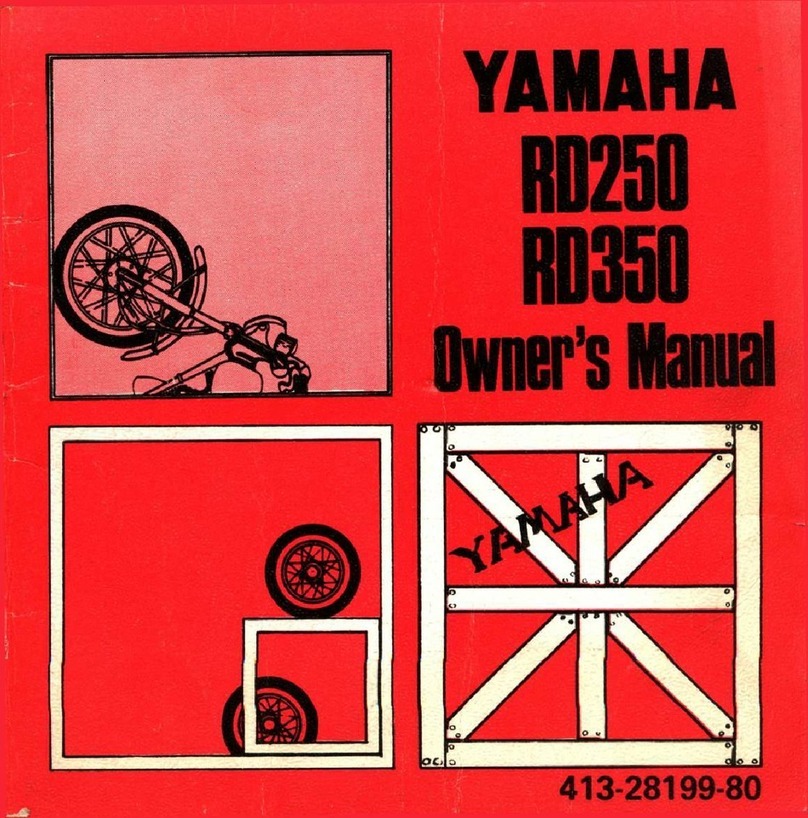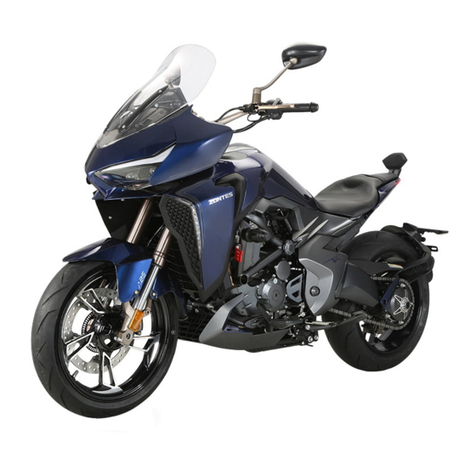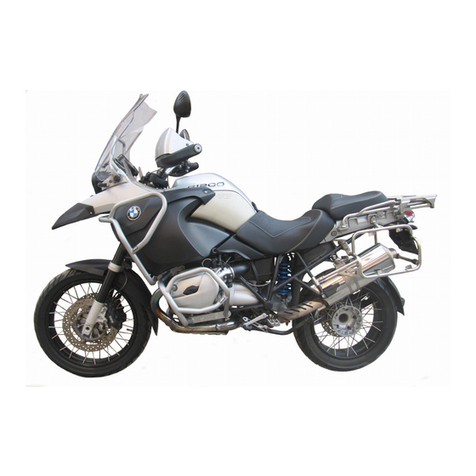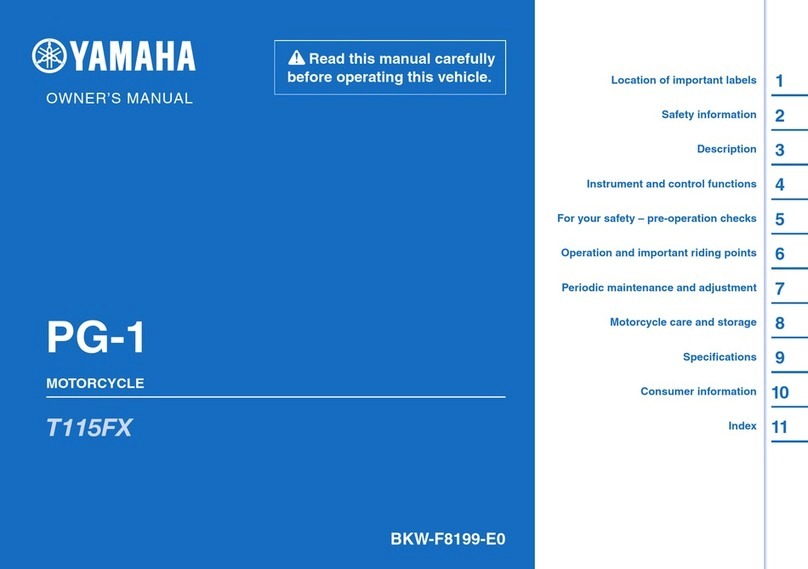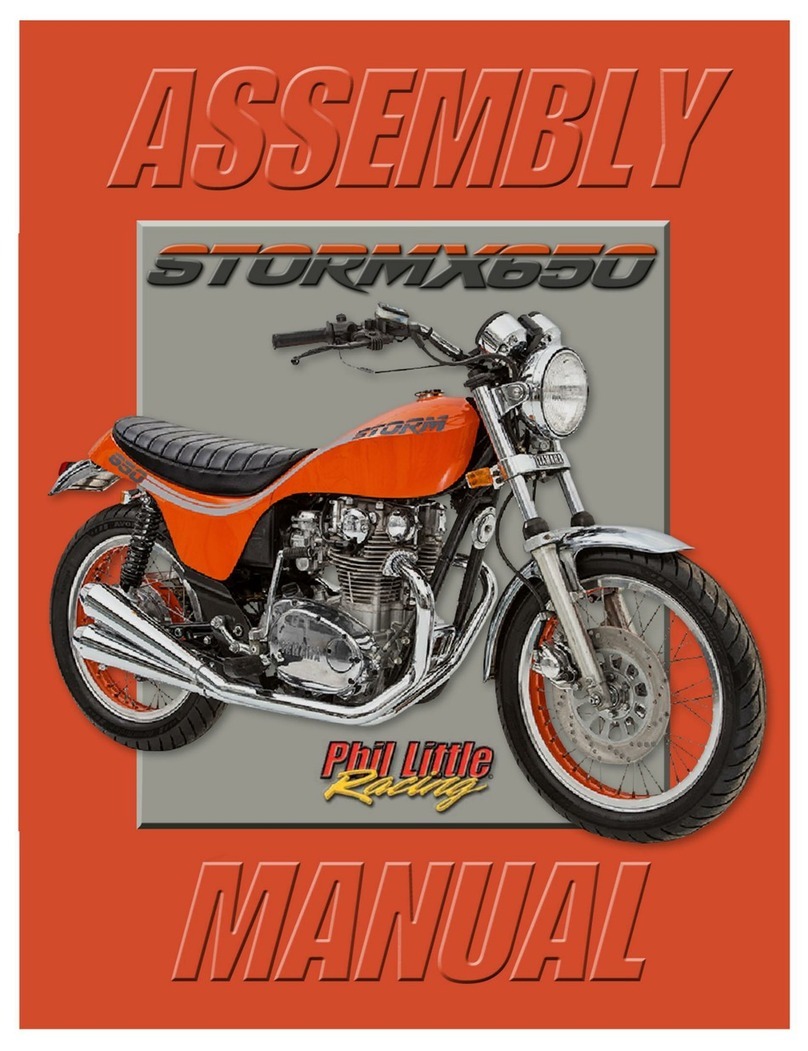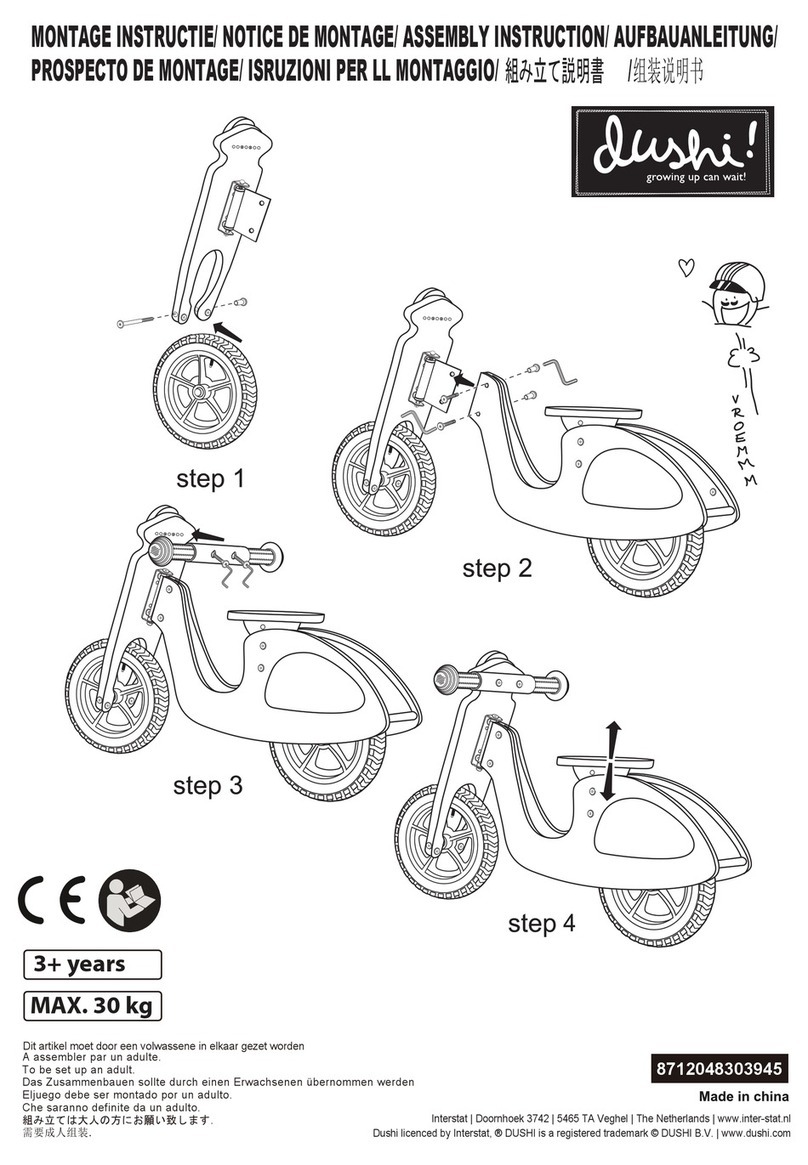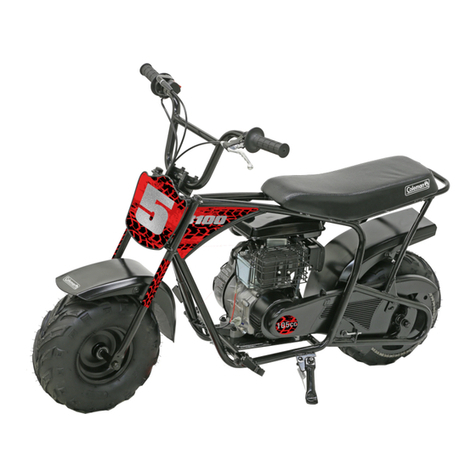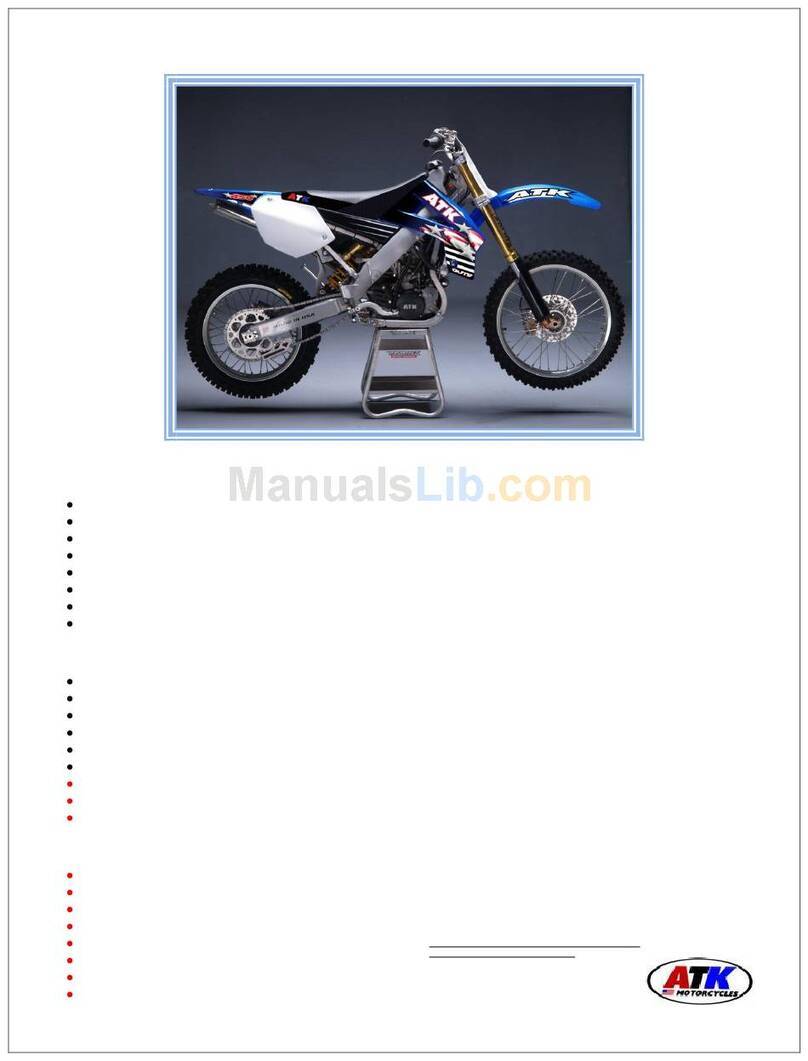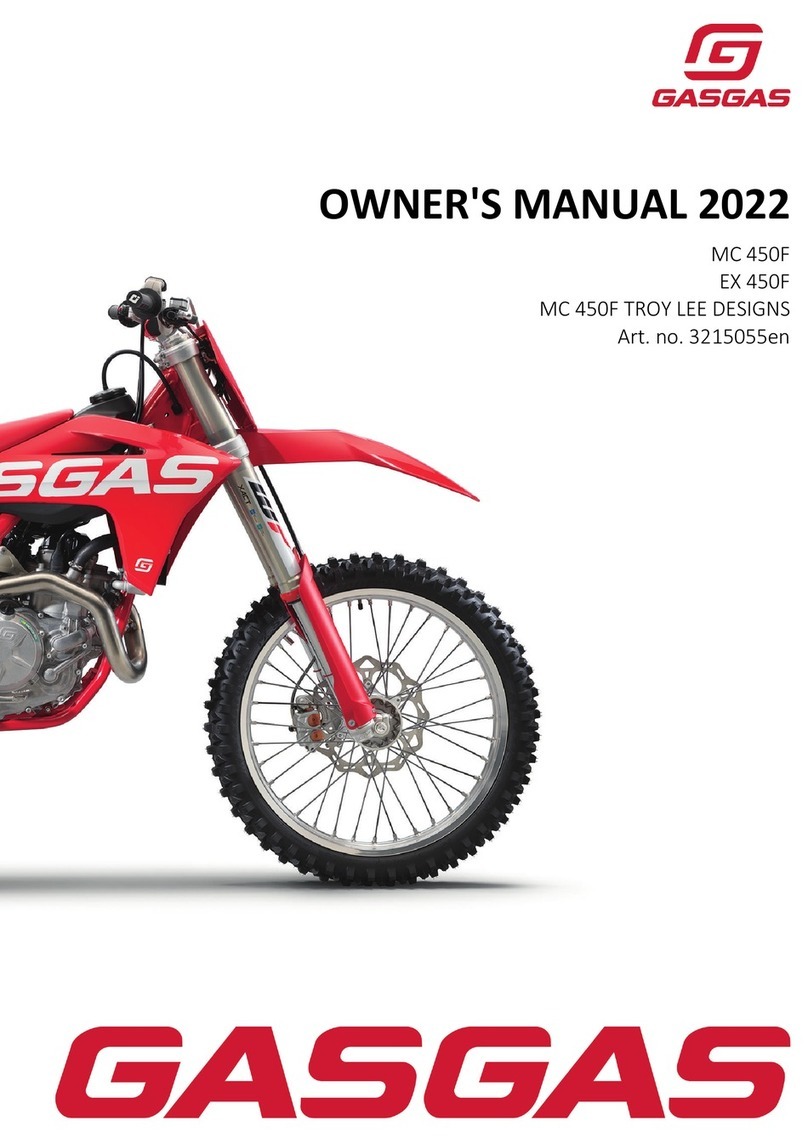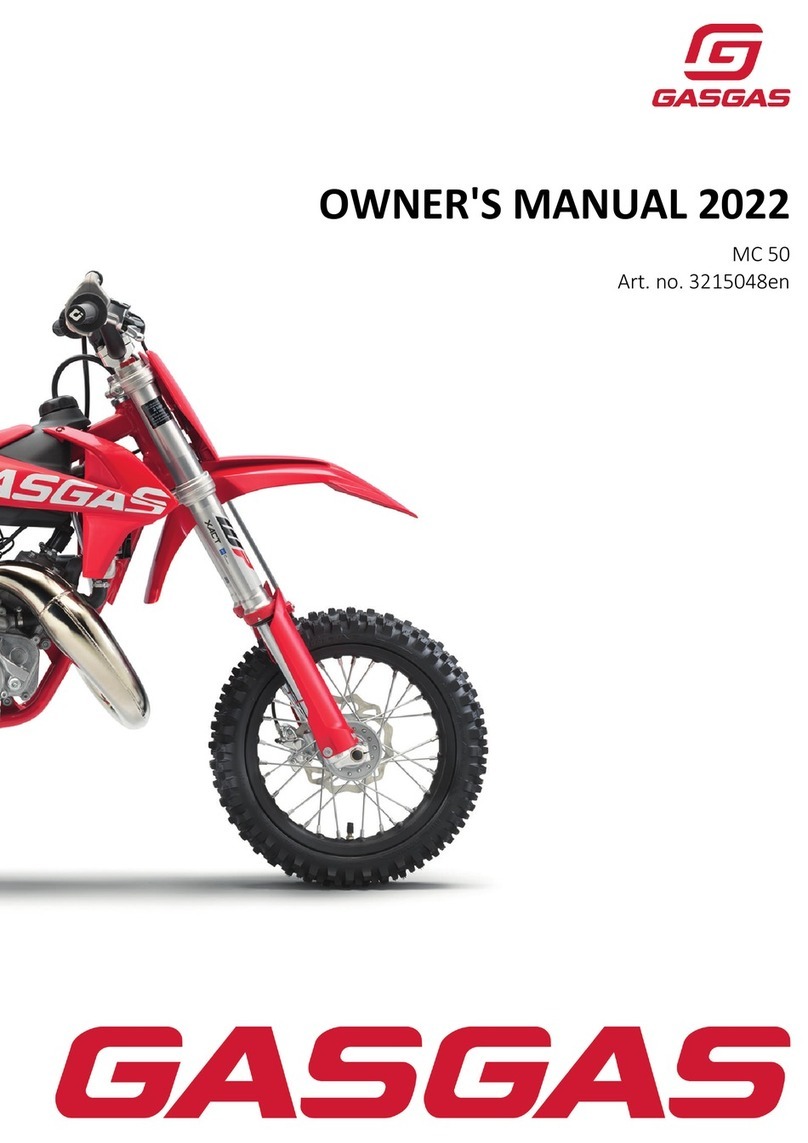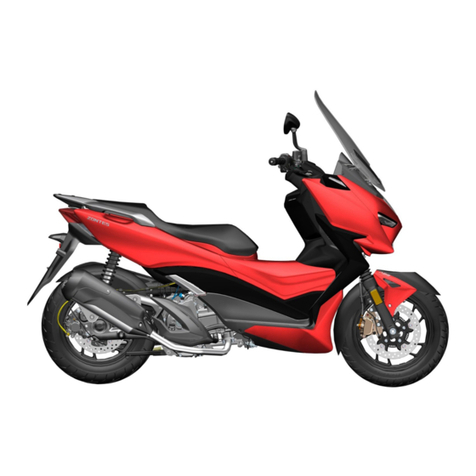Blata minimocard 2.6 Instruction manual



SAFETY WARNING
Always pay attention to the instructions and safety warnings below
This manual contains important safety information and instructions which should be read
carefully before operating the vehicle. For your own safety and the safety of others follow
these rules.
Neither manufacturer nor distributor is responsible for injuries caused by unsafe and improper
use of the vehicle.
This vehicle is not allowed to be used on public roads!
Unsafe and careless use of the vehicle can result in serious injuries. The driver can
minimize the potential risks by wearing safety equipment. The driver must wear a
safety helmet, goggles, gloves, elbow pads, kneepads, and firm footwear. Avoid rough
surfaces and obstacles. Always drive with both hands on the handlebars.
Fuel and fuel vapour are highly toxic and flamable. Always be careful when handling
fuel – it can burn or poison you.
- stop the engine and turn off the fuel tap, keep naked flames and sparks away from
your bike.
- do not smoke near your bike.
- refuel only outdoors in a well ventilated space
- clean up any excess fuel immediately
- keep children and pets away
Always ride within the limits of vehicle/ rider and weather conditions to avoid
unnecessary accidents and injuries.
Check-ups
Shut the engine off when performing maintenance check-ups otherwise You could be
severely injured if your hands or clothing get caught by moving parts.
Make sure the engine and exhaust are cold before performing any inspection of this
machine
Riding with a chain in poor condition or improperly adjusted can lead to serious injury.
Always, Inspect, Adjust and Maintain the drive chain properly before each ride.
Failure to inspect and properly maintain the brakes increases the risk of having an
accident. Before each ride check the brake cables and the brakes efficiency.
Riding with worn brake pads can reduce the braking performance and cause an
accident. Check and replace brake pads according to the instructions in this manual.
Using worn, improperly inflated, or incorrect tyres will reduce stability and can cause
an accident.
DISPOSAL OF UNUSABLE PRODUCT
Unusable product become a waste and it’s desposal should be in accordance with
the law and any applicable local regulations. Don’t throw this product to municipal
waste.
Always inspect the bike before each ride (refer to the article ‘INSPECTION AND
MAINTENANCE’). Failure to inspect and maintain your bike properly increases the risk
of an accident or damage to the vehicle.

MINIMOTARD 2,6
SERVICE MANUAL FOR USE AND MAINTENANCE AND SPARE PARTS LIST
OF MINIMOTARD
Before starting the operation of your Minimotard, read thoroughly these
directions. For your own safety and the safety of others Follow these
recommendations in order to use your Minimotard safely and correctly.
CONTENTS
PAGE
INTRODUCTION .............................................................................................................. 2
BASIC TECHNICAL DATA ...............................................................................................2
UNPACKING AND BASIC CONTROLS - FIG. 1 ............................................................3
SAFETY.............................................................................................................................3
BEFORE STARTING ....................................................................................................... 3
STARTING THE ENGINE - FIG. 2....................................................................................4
CARBURETOR - FIG. 3 ...................................................................................................4
RIDE ................................................................................................................................. 4
PERIODIC MAINTENANCE ..............................................................................................5
CHAIN SETTING ...............................................................................................................5
CLUTCH PADS REPLACEMENT .................................................................................... 5
ENGINE - EXPOSIVE VIEW..............................................................................................6
MINIMOTARD - EXPLOSIVE VIEW - FIG. 5.................................................................... 7
PART LIST .................................................................................................................... 8,9
FRONT AND REAR BRAKES - FIG. 7 ...........................................................................10
ADJUSTING THE BRAKES - FIG. 4 ............................................................................. 11
FRONT BRAKES PADS REPLACEMENT - FIG. 7 ....................................................... 11
REAR BRAKES PADS REPLACEMENT - FIG. 7 ......................................................... 11
DISMANTLING AND MOUNTING THE FRONT WHEEL - FIG. 5 ..................................11
DISMANTLING AND MOUNTING THE REAR WHEEL - FIG. 5 ....................................12
PINION EXCHANGE - FIG. 6 ..........................................................................................12
DISMANTLING AND ASSEMBLY OF AIR FILTER - FIG. 3 ..........................................12
STORAGE PROCEDURES .............................................................................................13

INTRODUCTION
Minimotard 2,5 is intended for a drive on closed tracks with even, smooth, and
dust-free surface. Both growns - up and children can ride on the Minimotard.
Children only under the supervision of a grown - up and responsible person. If
the terms of a track are fulfilled, the Minimotards can be used for races.
Minimotard is equipped with a single - cylinder, two - stroke, petrol
combustion engine, with a front and rear disc brake, the rear one being
controlled by a lever on the left side of handlebars and the front one by a lever
on the right side of handlebars, when seeing in the ride direction. The fuel
quantity controlled by a handle on the right side of handlebars. The engine is
fitted with an air filter and an exhaust silencer. The driving moment
transmission from engine to the driven rear wheel is carried out by a chain
drive the ratio of which can be changed to a small extend by a sprocket wheel
exchange on the rear wheel.
BASIC TECHNICAL DATA
ENGINE: TWO - STROKE ...............................................................AIR COOLED
DISPLACEMENT..................................................................... 39,9 ccm
POWER OUTPUT.................................................. 2,5 kW at 8 700 rpm
TORGUE ..............................................................3,5 Nm at 6 000 rpm
CARBURETOR .................................................................DELL’ORTO
IGNITION......................................................................... ELECTRONIC
STARTING ..............................................................................MANUAL
CLUTCH .....................................................CENTRIFUGAL, FRICTION
FRAME: WELDED ........................................ HIGH-STRENGTH STEEL TUBES
LINING: ........................................................................................ TWO PARTED
BRAKES: FRONT WHEEL.....................................MECHANICAL DISC BRAKES
REAR WHEEL.......................................MECHANICAL DISC BRAKES
WHEELS: FRONT WHEEL.....................................LIGHT ALLOY 2,1“ x 6,5“ - 90
REAR WHEEL.................................... LIGHT ALLOY 2,1“ x 6,5“ - 130
TIRES: FRONT ...................................................90/65 – 6,5“ WITH PATTERN
REAR.....................................................110/55 – 6,5” WITH PATTERN
FUEL: MIXTURE OF PETROL 91 OR HIGHER OCTANE + 2-STROKE
SYNTHETIC OIL
MIXING RATIO.............................................................................. 50 : 1
TANK CAPACITY...................................................................... 1 LITRE
MAX. SPEED (depends on mounted sproket wheel):..... up to 28 mph ( 45 km/ h)
UNLOADED WEIGHT..........................................................................39,7 lb ( 18 kg)
CARRYING CAPACITY.....................................................................242 lb ( 110 kg )
BASIC DIMENSIONS:
LENGHT ....................................................................................925 mm
WIDTH ...................................................................................... 580 mm
HEIGHT .................................................................................... 570 mm
2

UNPACKING AND BASIC CONTROLS
The Minimotard is packed and delivered with demounted handlebars . After
unpacking, set up the handlebars in a function position with two clamps and
set up that will suit you best. However at maximum handlebars turning, the
brake levers must not bump into the lining. After setting - up the handlebars,
tighten the handlebars clamp bolts 1 on handlebars sleeves, the brake levers
2, and acceleration handle 3 acc. to Fig. 1.At tightening, don´t use an
excessive force in order not to damage the parts or threads, or to distort the
tubes, and the like. Verify the smooth and perfect movement of operating
bowden cables of acceleration and both brakes.
Fig. 1
Basic controls:
1. Handlebars clamp bolts
2. Brake lever bolts
3. Acceleration handle screws
4. Stop switch
5. Front brake lever
6. Rear brake lever
SAFETY
Minimotard is not allowed to be used on public roads, as it doesn´t comply
with valid Safety Standards. It is forbidden to ride even where the traffic of
larger vehicles is possible. Minimotard is intended for a drive on closed tracks
with even smooth and dust-free surface.For your own and other people´s
safety keep all advices and recommandations, how to use your minimotard in
a correct and thoughtful way. serious injuries can result from unsafe operation
of this and other vehicles. You have to minimize the risk by wearing Safety
Equipment e. g. : crach helmet, goggles, gloves, guards of elbow and knees,
firm footwear.
BEFORE STARTING
Regarding the engine life time it is important the minimotard to be well run - in
as this fact will manifest itself by the power output and life of engine. The
minimotard is considered to be run - in after consuming five full fuel tanks by
riding. For brake-in period we use mixture of petrol and 2-stroke synthetic oil
in the ratio 30 : 1. After brake-in the petrol octane no. 91 or higher and 2-stroke
synthetic oil are mixed in ratio 50 : 1. Mix up throughly the mixture of fuel and
oil before pouring it into the tank. During brake-in don´t increase the engine
speed to maximum and don´t allow the overheating. Check the tire inflation
which should correspond to the driver ´s weight. The pressure in one wheel
has not to exceed 2,5 bar in the front and rear wheel.
3
5
311
22 46

STARTING THE ENGINE
To be done only on the starting stand - Fig. 2. After opening the tank filling
hole, fill the tank with fuel and close it by screwing - in cap.Open the petrol
supply cock by turning the small lever into position “ON”, Fig.3. Set the choke
lever into position “C” , Fig. 3. Without turning the accelerating handle, pull
gently twice the starting wire and by next quick pull start the engine. It is not
allowed to pull the starting wire up to full winding off. After a short engine run,
put the choke lever back to position “A” and let the engine run about 1 min.
Let the Minimotard on the larking stand and, if need be, adjust the no - load
speed to such a rate lest coupling should take along the no - load speed to
such a rate lest coupling should take along the rear wheel. For adjustment use
the adjustment screw No. 4 on the carburetor, Fig. 3.
Fig. 2
Fig. 3 CARBURETOR
ON OFF 1. Suction chamber
2. Sleeve screw
3. Carburetor body
4. Adjusting screw of no - load run
5. Float chamber
6. Fuel cock
A – choke lever for ride
B – choke lever for cold - starting
It is necessary to adhere to the following instructions for flange reassembling:
always use a new plastic ring 110.078.00 which is inserted into the flange!
Tighten up the screw with torque 5 Nm.
Use of bigger torque can cause carburetor damage which is not covered by
warranty !! Use of smaller torque can cause slackeing of the carburetor.
Check up the screw tightness after every 5 hours of riding!
RIDE
After mounting the Minimotard and slow turning the acceleration handle, you
are starting your ride. Before braking, turn back the acceleration handle and
depress slightly the front brake lever and then the rear brake lever. Beware of
the wheels not to get them in skid.
4

The Minimotard engine will be switched off by pusching the red pusch -
buttom of the stop switch on handlerods. After the first half- hour ride it is
necessary to check the tightening of screws and nuts, especially of the engine.
Check also the brake setting.
PERIODIC MAINTENANCE
The periodic maintenance is the best way how to contribute to the machine life
prolongation, ride safety, and cost decrease. In addition, you will be spared
many worries, time and troubles.
A - Before every ride:
1. Check the Cables and efficiency of brakes.
2. Check the lubrication and chain tension settings. The chain free play
should be (5 mm) (.200in) After every ride clean the minimotard carefully
and keep it clean. Do not use aggressive cleaning detergents.
3. After 1-hour of use, wash the air filter in air drying spirits and lubricate it
with special oil for air filters.
B. After every 5 hours of riding:
4. Check the tightness of all bolts and nuts. Tighten carefully to prevent
damage to other parts.
5. Wash the air filter in gas and lubricate it with special oil for an air filters to
better catch the dust.
6. Clean carefully the carburetor float chamber.
7. Check the brake pads, the thickness of brake lining cannot be less than 1
mm (.039 in). Review the basic brake adjustment.
8. Check the state of the clutch pads - the thickness cannot be less than 1
mm (.039in).
C - Every time after 10 hours of riding:
9. Check the state of the clutch pads - the thickness cannot be less than 1 mm
(.039in).
CHAIN SETTING:
When setting up the chain attachment of the rear brake reaction catcher and
the rear wheel axle nut 920.011.01. Then tighten uniformly the chain tighteners
on both sides of rear wheel by means of nuts 920.009.01 , Fig. 5. When the
chain is set - up to reguired sag 0,196” (5 mm), tighten the nut 920.011.01 of
the rear wheel and the screw of
If there is need to replace the chain, check also both chain wheels. In case
they are worn-out, they must be replaced by new ones at the same time with
the chain.
REPLACEMENT OF THE CENTRIFUGAL FRICTION CLUTCH PADS:
Unscrew the fastening screws and remove the chain cover. Release the chain
and dismantle it. Unscrew four screws 914.010.01 and 914.011.01 keeping the
cover with drum of the clutch. Release the engine brace on the frame, shift it
out, and remove the whole cover with clutch drum. By means of pliers draw off
the clutch springs and loosen the pins holding the clutch levers. At the new
clutch levers put the clutch pins and at assembly proceed in a revers
sequence and, in the end, adjust the chain sag.
5

6

7
347.010.70

MINIMOTARD – 2,6
170.000.00 MINIMOTARD 2,6 510.002.00 STARTER COMPLETE
ENGINE 510.003.00 STARTER ROPE
110.001.00 ENGINE COMPLETE 510.004.00 HOLDER
110.001.01 ENGINE PROPER 510.005.00 HOLDER
110.002.00 CARBURETTER SHA 1412L 510.006.00 GUIDE BUSH
110.004.00 PISTON COMPLETE - A 510.007.00 STARTER CASE
110.004.01 PISTON COMPLETE - B 510.008.00 STARTER SPRING
110.004.02 PISTON COMPLETE - C 510.009.00 RATCHET WHEEL
110.004.03 PISTON COMPLETE - D 510.011.00 WASHER 4,5 x 16 x 1,5
110.005.00 PISTON RING 510.015.00 WASHER 8,1 x 16 x 1
110.006.00 PISTON - A 510.017.00 WASHER 6,1 x 16 x 1,5
110.006.01 PISTON - B 510.020.00 PINION 6Z
110.006.02 PISTON - C 510.020.01 PINION 7Z
110.006.03 PISTON - D FRAME
110.008.00 WRIST - PIN 171.001.00 FRAME, VARNISHED
110.011.00 CRANK BALANCED 171.020.00 NUT HOLDER
110.015.00 CLUTCH DISC BRAKES
110.017.00 CLUTCH LEVER - 2 PCS 112.004.00 LIFTER, RIGHT
110.019.00 CLUTCH SCREW COMPLETE 112.025.01 FRONT BRAKE DISC 2,5 x 119
110.020.00 CLUTCH SCREW SCREW 312.040.02 REAR BRAKE DISC 3,0 x 119
110.021.00 CLUTCH SPRING - SERIE 1,25 - 2PCS 112.050.02 BRAKE HOLDER
110.022.00 CLUTCH SPRING - RACING 1,4 - 2PCS 112.060.00 BRAKE COMPLETE
110.023.00 CLUTCH SPRING - RACING 1,6 - 2PCS 172.006.00 BOWDEN CABLE - FRONT BRAKE
110.024.00 CLUTCH DRUM 172.007.00 BOWDEN CABLE - REAR BRAKE
110.028.00 CLUTCH CASE 312.017.00 LIFTER LEVER
110.031.00 CLUTCH CASE COMPLETE 312.029.00 SPRING, LEFT
110.032.00 CLUTCH COMPLETE 312.035.00 WASHER 6,1 x 14 x 3
110.053.00 ENGINE COVERING 312.041.00 WASHER 10,5 x 18 x 3
110.055.00 ENGINE SEALING SET 332.020.00 NUT
110.056.00 FLANGE 512.004.00 HANDLE BAR LEVER, RIGHT
110.057.00 DIAPHRAGM SEALING - 2PCS 512.005.00 HANDLE BAR LEVER, LEFT
110.059.00 DIAPHRAGM 512.008.10 LIFTER, LEFT
110.060.00 DIAPHRAGM WASHER 512.016.50 TERM. CLAMP BOWDEN
110.063.00 SEALING ENGINE BLOCK 512.019.01 WASHER
110.065.00 ENGINE BLOCK 512.042.00 DISTANCE SLEEVE
110.067.00 DIAPHRAGM COMPLETE 512.043.00 BRAKE PIN
110.068.00 SEALING 512.044.00 LIFTER PIN
110.069.00 CYLINDER - A 512.045.00 BOWDEN HOLDER
110.069.01 CYLINDER - B 512.053.00 FRONT BRAKE CASE - 1 PAIR
110.069.02 CYLINDER - C 512.054.00 DISC BRAKE PADS - 2PCS
110.069.03 CYLINDER - D 512.055.00 BRAKE COMPLETE
110.070.00 CYLINDER + PISTON COMPLETE 512.058.00 REAR BRAKE CASE - 1 PAIR
110.072.00 EXHAUST SEALING 512.060.00 SPRING RIGHT
110.073.00 PLASTIC CONECT, FUEL COCK WHEELS
110.074.00 FUEL COCK 113.008.00 AXLE OF WHEEL
110.075.00 EXHAUST COMPLETE 113.009.00 AXLE OF WHEEL
110.076.00 EXHAUST SILENCER COMPLETE 113.015.00 DISTANCE SLEEVE, 14,5 mm
110.077.00 SILENCER MASS 133.002.20 TIRE W. PATTERN 90/65 – 6,5“
110.078.00 RING 133.010.20 TIRE W. PATTERN 100/55 – 6,5“
110.080.52 JET 52 153.033.00 CHAIN ADJUSTER, COMPLETE
110.097.00 FLOAT CHAMBER SEALING 193.001.00 BRAKE DISC WASHER
110.098.00 CARBURETOR SEALING 1 193.002.00 SPROCKET WASHER
110.099.00 ADJUSTING SCREW 193.003.00 BRAKE DISC WASHER
110.100.00 THROTTLE VALVE 193.020.00 WHEEL 2,1“ x 6,5“ – 90 without tire
110.101.00 CARBURETOR FILTER 193.021.00 WHEEL 2,3“ x 6,5“ – 130 without tire
110.102.00 NEEDLE VALVE 313.002.00 VALVE 90º - TUBLES
110.103.00 FLOAT 313.010.02 DISC 2,1“ x 6,5“ - 90
110.104.00 CARBURETOR SEALING 2 313.011.02 DISC 2,3“ x 6,5“ - 130
110.105.00 THROTTLE VALVE SEALING 513.011.04 DISTANCE SLEEVE 84,5 mm
110.185.00 JET SET 513.011.06 DISTANCE SLEEVE 117,3 mm
340.062.00 WASHER 5,5 x 15 x 4 513.011.09 DISTANCE SLEEVE 86,8 mm
8

LINING 119.011.00 RUBBER FOR FRAME
114.015.00 CHAIN COVER 119.013.00 HOSE CLAMP
114.016.00 CHAIN COVER, POLISHED 119.020.00 STAND
174.001.00 LINING COMPLETE, NON VARNISHED 119.035.00 WASHER 6,4 x 18 x 1
174.002.00 LINING COMPLETE, VARNISHED 129.008.00 HOSE CLAMP
174.004.00 SADDLE, NON VARNISHED 129.017.00 WASHER 6,4 x 16 x 1
174.005.00 FRONT FENDER, NON VARNISHED 199.002.00 LABEL COMPLETE, ONE MODEL
174.007.00 SADDLE VARNISHED 179.008.00 TANK WITH CAP
174.008.00 FRONT FENDER, VARNISHED 179.009.00 TANK
174.022.00 SADDLE 179.012.00 GAS TUBE
514.008.00 RUBBER WASHER 4 x 6,5 x 23,5 319.050.00 PINION KEY
CONTROL 329.001.01 FOOT REST, 2 PCS
195.001.00 FORK LEFT WITH BRAKE HOLDER JOINING ELEMENTS
195.002.00 FORK RIGHT 911.007.01 SCREW M 10 x 140
115.018.01 CAP 912.005.02 SCREW M 5 x 16
175.005.00 HANDLE BAR TUBE 912.006.02 SCREW M 5 x 16
912.007.01 SCREW M 5 x 16
175.014.00 HANDLEBAR HOLDER - 1 PAIR 914.001.01 SCREW M 5 x 16
175.016.00 GAS BOWDEN CABLE 914.003.01 SCREW M 5 x 20
175.021.00 HOLDER ABOVE - COMPLETE 914.005.01 SCREW M 5 x 30
175.022.00 HOLDER BELOW - COMPLETE 914.007.01 SCREW M 6 x 16
175.025.00 HANDLEBAR BRACKET COVERING 914.008.01 SCREW M 6 x 20
175.026.00 PAD OF COVERING 914.011.01 SCREW M 6 x 30
515.002.00 HAND GRIPS - 2 PCS 914.015.01 SCREW M 8 x 45
515.006.00 THROTTLE GAS 914.021.01 SCREW M 6 x 12
515.007.00 BOWDEN DUST GUARD 914.026.01 SCREW M 5 x 12
515.008.00 ADJUSTING SCREW 914.080.01 SCREW M 6 x 14
915.001.01 SCREW M 4 x 8
TRANSMISSION 915.004.01 SCREW M 4 x 10
347.010.64 SPROCKET NO. TEETH 64 916.012.01 SCREW M 6 x 12
347.010.65 SPROCKET NO. TEETH 65 916.020.01 SCREW M 6 x 40
347.010.66 SPROCKET NO. TEETH 66 916.055.01 SCREW M 5 x 16
347.010.67 SPROCKET NO. TEETH 67 916.072.02 SCREW 5 x 20
347.010.68 SPROCKET NO. TEETH 68 917.010.01 SCREW 5 x 16
347.010.69 SPROCKET NO. TEETH 69 920.001.01 NUT M 5
347.010.70 SPROCKET NO. TEETH 70 - SERIE 920.006.01 NUT M 6
347.010.71 SPROCKET NO. TEETH 71 920.008.01 NUT M 5 SELFLOCKING
347.010.72 SPROCKET NO. TEETH 72 920.009.01 NUT M 6 SELFLOCKING
347.010.73 SPROCKET NO. TEETH 73 920.010.01 NUT M 8 SELFLOCKING
347.010.74 SPROCKET NO. TEETH 74 920.011.01 NUT M 10 SELFLOCKING
347.010.75 SPROCKET NO. TEETH 75 920.012.01 NUT M 8 LEFT
117.015.00 CHAIN CLASP 920.015.01 NUT M 6
117.015.01 CHAIN CLASP 930.003.01 WASHER 10,5
517.001.40 CHAIN 142 930.009.00 WASHER 6,4
517.001.44 CHAIN 144 930.010.00 WASHER 8,4
517.001.46 CHAIN 146 - SERIE 930.011.00 WASHER 8,1
517.001.48 CHAIN 148 940.006.00 ROLLER 6 x 6
EL. INSTALLATION 950.003.00 WOODRUFF KEY 3e7 x 3,7
118.001.00 SPARK COIL 950.005.00 WOODRUFF KEY 2e7 x 3,7
118.002.00 ROTOR COMPLETE 950.007.00 LOCK 15
118.003.00 SPARK PLUG 950.008.00 LOCK 35
118.005.00 SPARK PLUG CONNECTOR 950.010.00 PISTON PIN LOCK RING
118.010.00 ZIP TIES 3,6 x 140 960.003.00 BEARING 6000 ZR
518.001.00 KILL SWITCH 960.004.00 BEARING 6200 ZR
OTHER PARTS 960.006.00 BEARING 6202 C3
119.003.00 DISTANCE SLEEVE 25,8 960.007.00 BEARING 6202 2ZR
119.005.00 CHAIN ROLLER 960.108.00 CONNECTING ROD BEARING
119.006.00 HOLDER ENGINE 970.001.00 PACKUNG RING 12 x 22 x 7
119.010.00 SCREW CAP 970.002.00 PACKUNG RING 15 x 26 x 7
9

10
916.072.02
916.072.02

ADJUSTING THE BRAKES
Fig. 4 Small incremental brake adjustment :
Free play at the handlebar lever is
effected by turning the knurled end on the
cable adjustor. This will allow the lever to
be set at the nominal to ¼ inch of free
lever movement.
Basic brake adjusting:
Screw in the knurled cable adjustor at the
brake lever so the cable is in it’s most
slack starting position.. At the caliper,
loosen the nut, No. 3 and tighten the
adjustable bolt No. 4, so the wheel cannot
turn. Back off bolt No. 4 about ¼ to ½ of a
turn and fix it with lock nut No. 3. Do not
use the cable retainer No. 5 for adjusting
the brakes!
FRONT BRAKE PADS REPLACEMENT: FIG.7
At first, screw in the knurled cable adjustor at the brake lever on the
handlebars. Unscrew two screws M5-914.003.01 that hold the brake body on
fork and shift out the brake backwards. Take out from brake body two distance
columns and two columns with coil. Do not loosen the cable retainer! Unscrew
screws M6-914.010.01 and separate both halves of brake body and shift the
worn-out brake plates out. Into the part with operating mechanism slide the
brake plate with pin bore and unscrew completely the adjusting screw. Force
on carefully the brake plate into the opposite piece. Before reassembly clean
the whole brake. Assembly follows in reverse sequence.
REAR BRAKE PADS REPLACEMENT: FIG. 7
At first, screw in the knurled cable adjustor at the brake lever on the
handlebars. Unscrew two screws M5-914.003.010 that hold the brake body on
brake holder and shift out the rear brake backwards. Take out from brake body
two distance columns and two columns with coil. Do not loosen the cable
retainer ! Unscrew screws M5-914.003.01 and separate both halves of brake
body and shift the worn-out brake plates out. Into the part with operating
mechanism slide the brake plate with pin bore and unscrew completely the
adjusting screw . Force on carefully the brake plate into the opposite piece.
Before reassembly clean the whole brake. Assembly follows in reverse
sequence.
DISMANTLING AND MOUNTING THE FRONT WHEEL, FIG. 5
Unscrew the nut M10 – 920.011.01 of the front axle and shift it out. By light pull
shift downwards the wheel.For an easier mounting of the wheel dismantle left
fork with freeing the screws M5 on the fork holders.At the first, for the
mounting of the wheel carefully route the front brake and the wheel with brake
disk to put inside the brake disk between the brake plates.Put the wheel on an
axle, mount the right fork and tighten the nut M10 of wheel axle.
11
3
4

DISMANTLING AND MOUNTING THE REAR WHEEL, FIG. 5
Unscrew the rear axle nut 920.011.01 and loosen the nuts 920.009.01 on chain
tighteners and the screw M6 on . Shift the wheel forward and remove the
chain. At pulling out the wheel axle, secure the rear wheel two distance rollers
fall out.
The wheel mounting to be carried out in reverse sequence. It is necessary to
see to the right location of distance rollers. Use the shorter roller on the site of
chain wheel and the longer one at the brake disc. Don´t forget to tighten right
the chain, tighten the wheel axle and check the rear brake function.
PINION EXCHANGE: FIG. 6
First dismantle the front
lining and chain guard. Loosen
the nut of rear wheel axle and
the nut of chain tightener,
remove chain. Insert carefully
a larger screwdriver or steel
rod into the hole of clutch
drum, Fig. 6, to avoid a turning
over the clutch drum at
releasing the pinion. Using the
pinion wrench P/ N 319.050.00,
release the new pinion to be
carried out by reverse way.
Fig. 6
REPLACEMENT OF TIRE – FIG. 5
Remove the wheel from the minimotard. For the front wheel unbolt the brake
disk and for the rear wheel, the brake disk and sprocket. Deflate the tire, by
removing the valve stem. Place the wheel on a hard surface and press the tire
bead from the wheel rim in to the middle relief at centre of rim. Tire is ready to
be removed from the rim at this time and is done in the conventional manner.
After fitting new Tire and Tube (if necessary) to the rim, you can inflate 28 to
30 psi. Take care to check that the tire bead is fully seated in the rim bead
edge. You can now refit the wheel to the bike in reverse order to removing it.
Use Caution and recheck your work always.
DISMANTLING AND ASSEMBLY OF AIR FILTER, FIG. 3
Dismantling the air filter unscrew 2 and so ease the holder and put down the
suction chamber 1. On this way you gain acces to the filter, that you can take
off by means of screw driver. After cleaning and lubricating it with engine oil
proceed the assembly on a reverse sequence.
12

NON USE AND STORAGE PROCEDURE
It is recommended to drain out all fuel from the tank and carburetor. Inflate the
tires to the working pressure and put the minibike on the stand. During a *long
storage period, unbolt the spark plug and insert a couple of drops of the motor
oil into the cylinder. Pull the starting rope a couple of times so a film of oil
covers and evenly coats the cylinder walls and piston rings.
* Long period is 90 days and longer.
Rights reserved for technical, text and design changes of the BLATA
Company.
It is a great honor for us, that you have chosen our product. We believe that
the MINIBIKE will work for you without problems and will bring you much
pleasure and fun.
The producer of the MINIBIKE is BLATA Company.
Manufacturing Number CZ …………………….........
Signature of the technical control: ………………………
This manual served also as a guarantee list. Please, after receiving the product
check the manufacturing number and the date of sale. In the case of a claim it
is necessary to submit this guarantee list.
Date, stamp and signature of the dealer:
The entire construction solution for minimotard and used disc brakes are
protected by industrial design.
No part of this publication may be reproduced without an explicit
consent of BLATA COMPANY !
Copyright © BLATA
Table of contents
Other Blata Motorcycle manuals
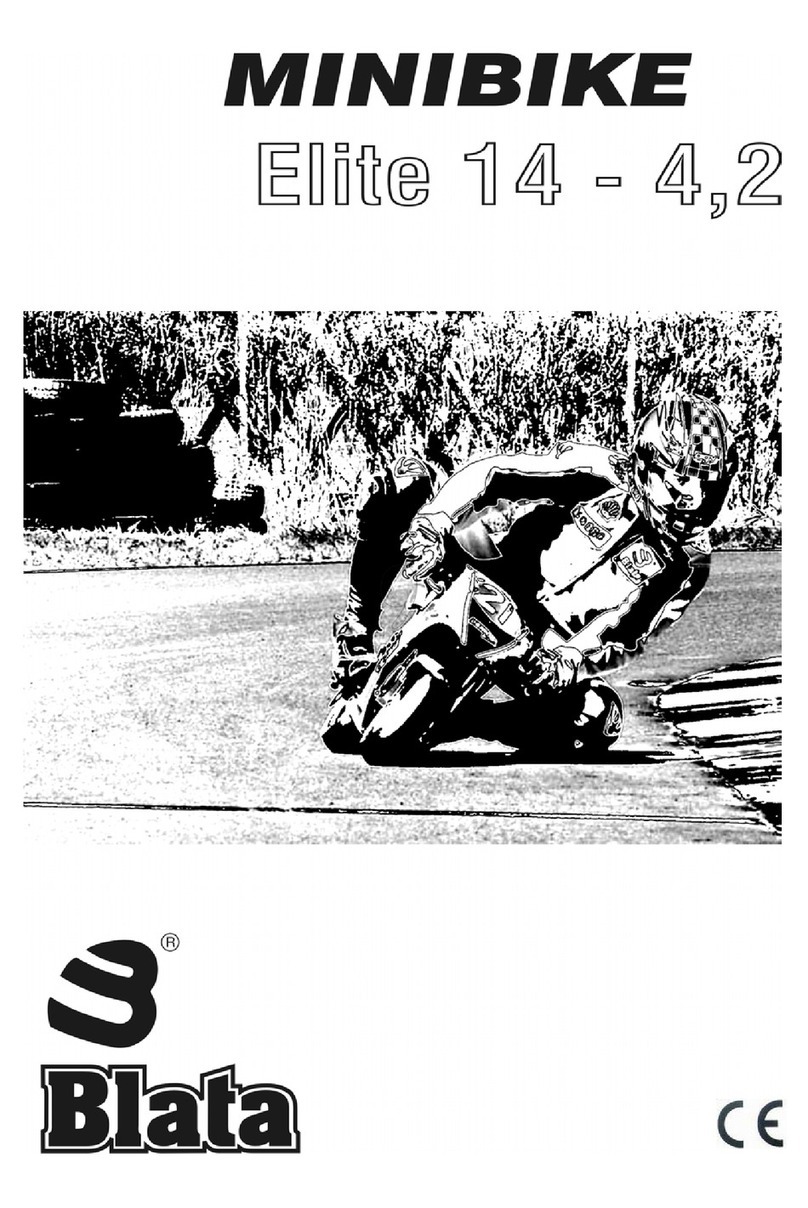
Blata
Blata Elite 14 - 4 User manual
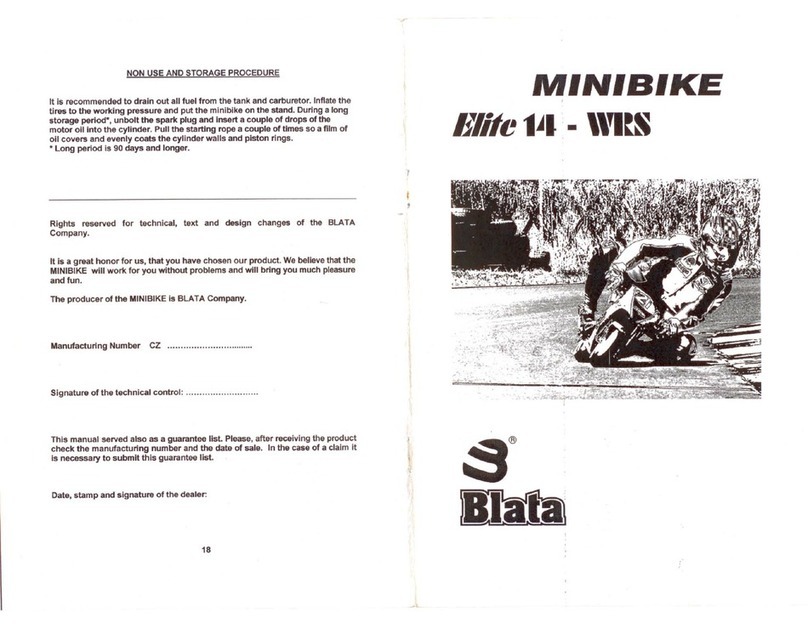
Blata
Blata ELITE 14-WRS User manual
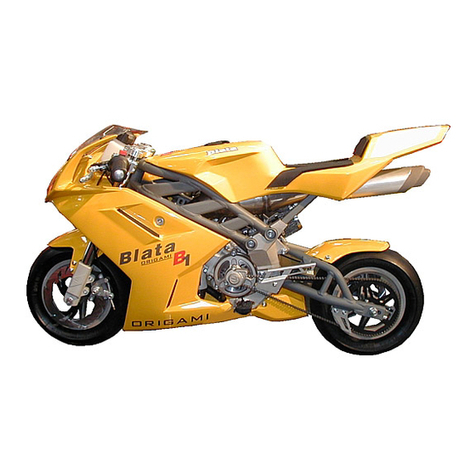
Blata
Blata Origami B1 User manual

Blata
Blata Origami B1 User manual
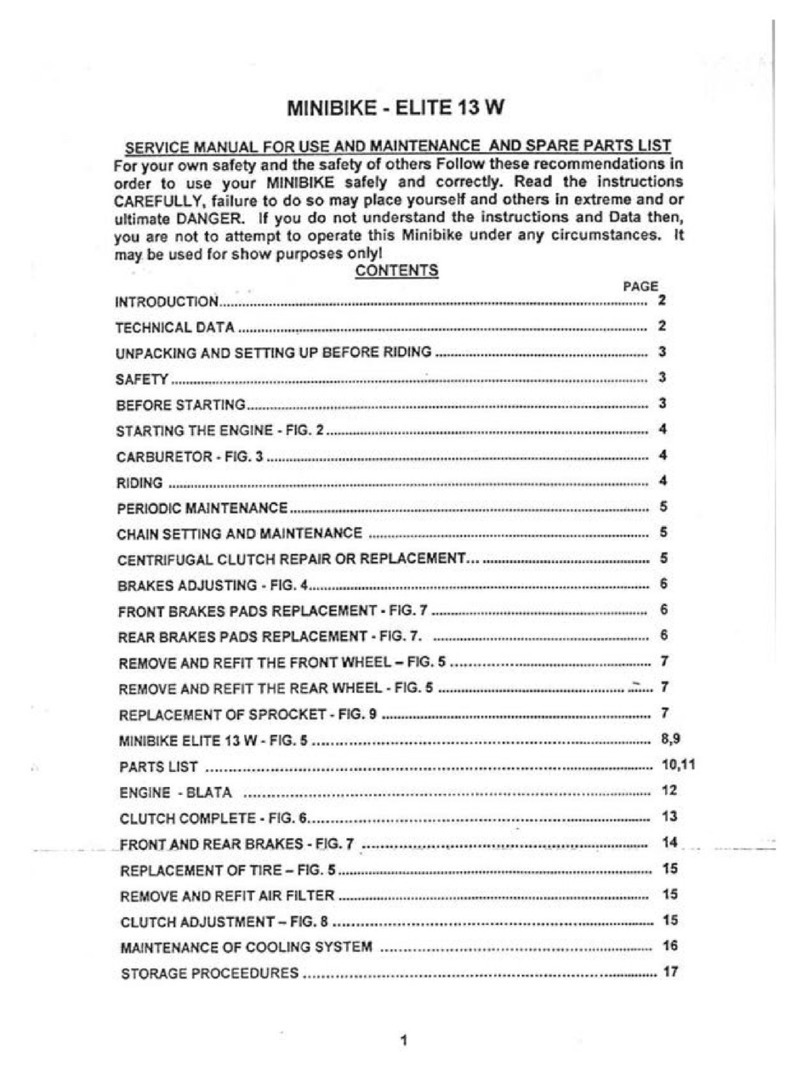
Blata
Blata Elite 13 W User manual
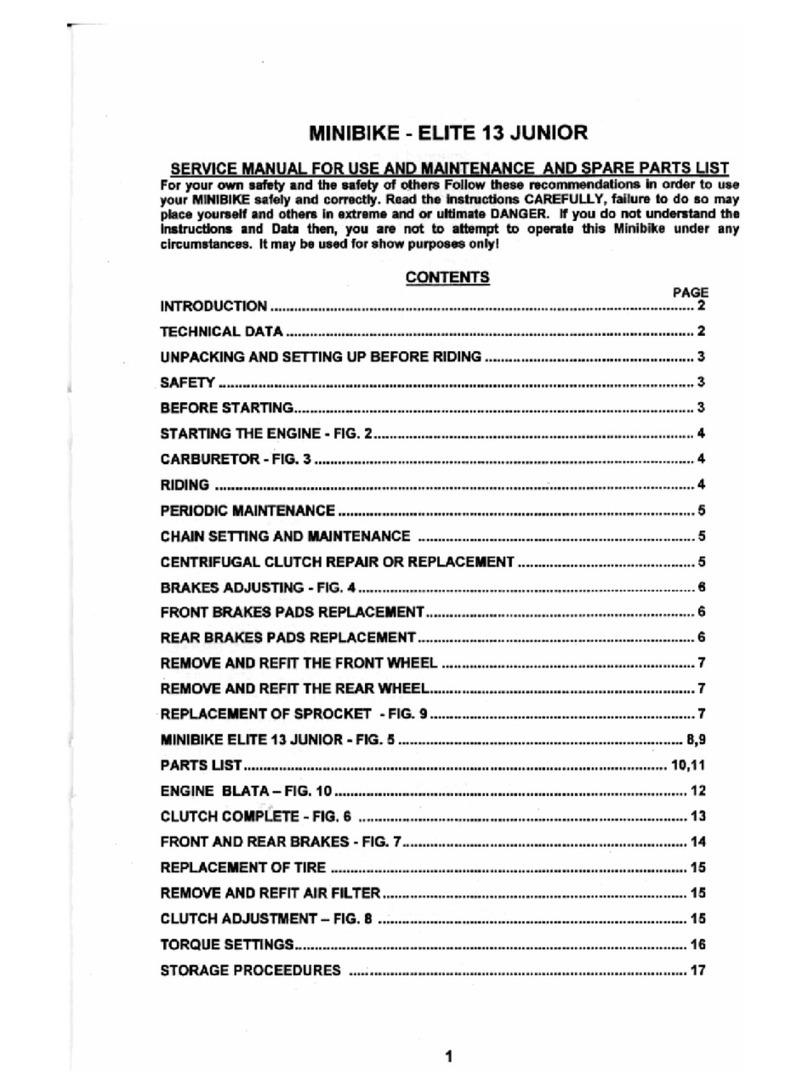
Blata
Blata Minibike Elite 13 Junior User manual
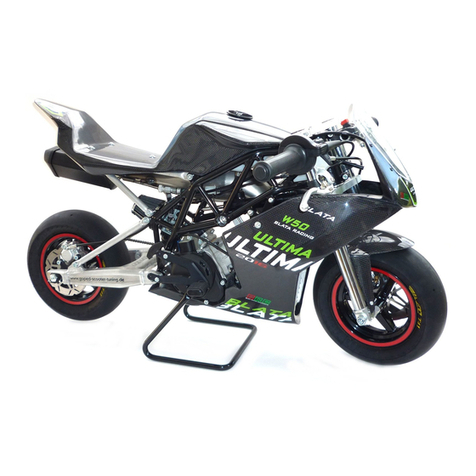
Blata
Blata Ultima User manual

Blata
Blata MOTARD 125 BXM User manual
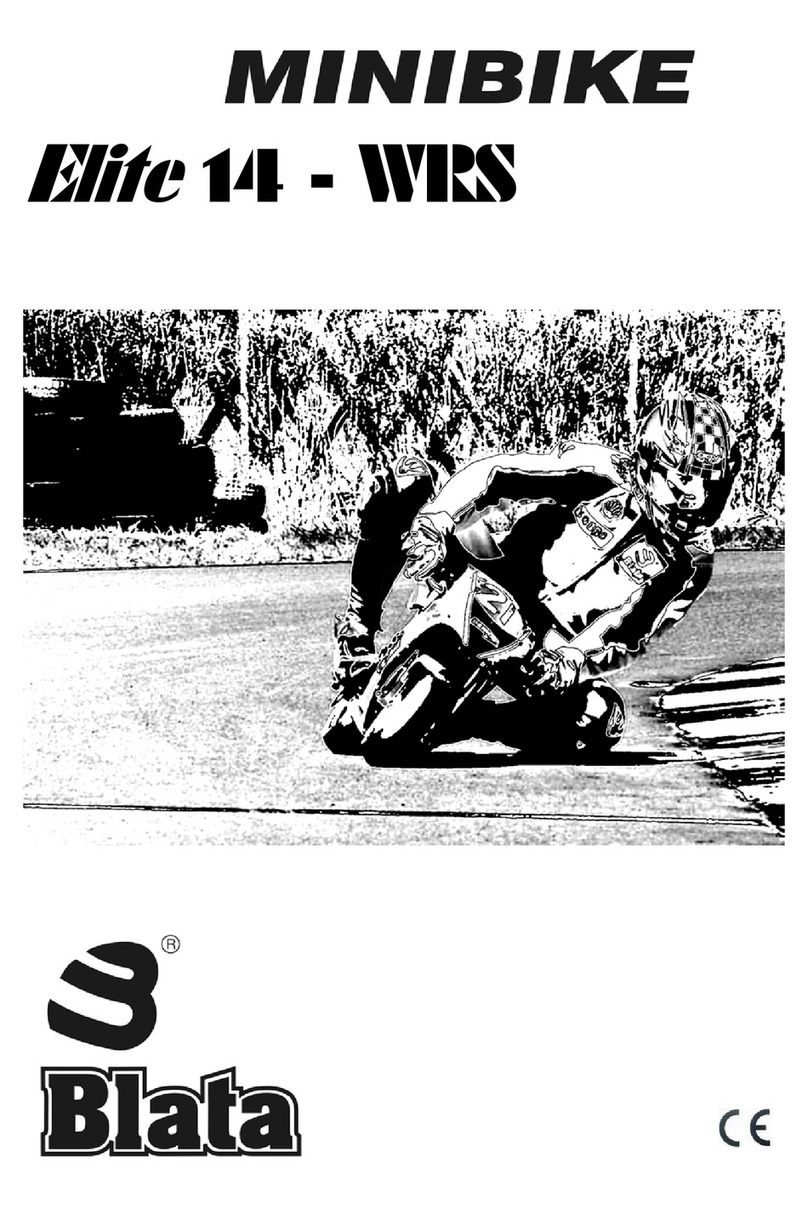
Blata
Blata Minibike Elite 14 WRS User manual
